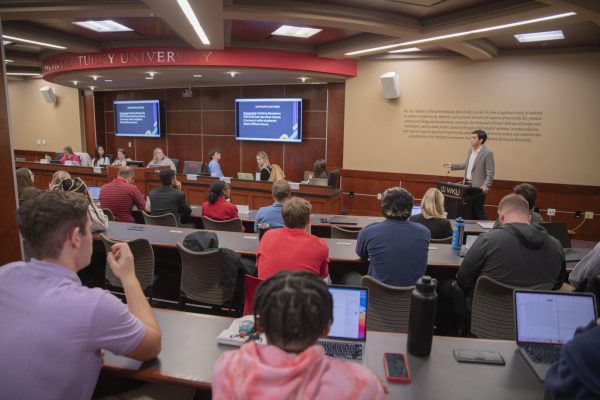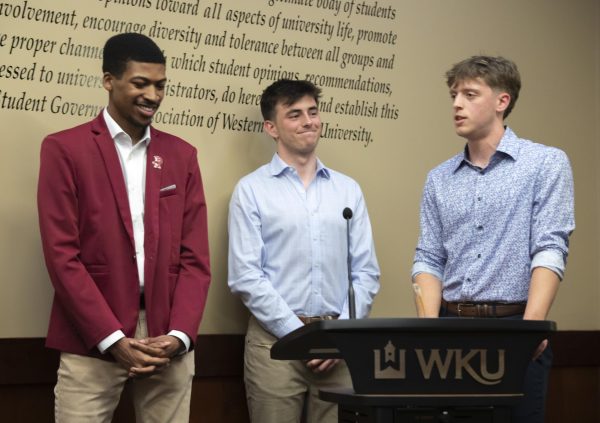Report: Grad rates unfair
April 15, 2004
Julie Watson, a freshman from Murfreesboro, Tenn., will pack her bags at the end of the semester and leave Western – probably for good.
She’ll be enrolling at Middle Tennessee State University in Murfreesboro in the fall.
Watson and other students who transfer may cause the university’s graduation rates to fall.
The manner in which most schools’ graduation rates are compiled may be shortchanging students and universities, stated a report from the U.S. Department of Education.
A school’s graduation rate may not reflect the full success of students or the school itself, said Clifford Adelman, senior research analyst for the U.S. Education Department. Graduation rates nationwide are compiled based on the number of first time, full-time freshmen who graduate after six years at an institution.
Students who transfer from one institution to another aren’t counted in either school’s graduation rates.
There are a variety of reasons a student might transfer, Adelman said.
“We have a highly mobile student population,” Adelman said. “One out of five students who earn a bachelor’s degree earns it at a place they didn’t start at.”
But the universities those students attended will have no way of recording their progress, Adelman said.
The Kentucky Council on Post-Secondary Education uses federal standards to calculate graduation rates, said Sherri Noxel, CPE director of information and research. Those standards include counting only students who begin as first time, full-time freshmen and graduate in six years time from the same school.
Recording the success of transfer students is not an option for state universities or the CPE at this time, Noxel said.
It would be good if Western could at least keep a record of those students who transfer to other institutions within Kentucky, said John Petersen, associative vice president for academic affairs.
Some universities, including Western, keep records of the number of students that leave, Knoxel said.
Western had a 14 percent transfer rate for students who began as freshmen in 1996, according to data compiled by the National Center for Education Statistics. The six-year graduation rate for students who remained at Western was 39.1 percent.
That rate doesn’t include students who began their time at Western after 1996 or as transfer students.
Eastern Kentucky University had a transfer rate of 19.6 percent and a graduation rate of 32.7 percent for the same group of students, according to data compiled by the center.
Kentucky’s universities do not operate on a performance-based funding system, therefore low graduation rates do not hurt the amount of financial aid the schools’ students receive, said Sandra Woodley, CPE vice president of finance said.
Some universities in the country work closely with community colleges and allow students to take courses at both, Adelman said.
Many students who take alternate courses between community colleges and universities may be counted as transfer students. That will lower graduation rates, he said.
Transfer students affect Western’s graduation rates to some degree and may lower them, Petersen said.
“I think we are making some progress …” he said. “In principle, it is something that should be addressed.”
Ohio, Oklahoma, and Virginia are the only states that track students who transfer within those states.
Reach Adriane Hardin at [email protected]











![Students cheer for Senator at Large Jaden Marshall after being announced as the Intercultural Student Engagement Center Senator for the 24th Senate on Wednesday, April 17 in the Senate Chamber in DSU. Ive done everything in my power, Ive said it 100 times, to be for the students, Marshall said. So, not only to win, but to hear that reaction for me by the other students is just something that shows people actually care about me [and] really support me.](https://wkuherald.com/wp-content/uploads/2024/04/jadenmarshall-1200x844.jpg)




![Students cheer for Senator at Large Jaden Marshall after being announced as the Intercultural Student Engagement Center Senator for the 24th Senate on Wednesday, April 17 in the Senate Chamber in DSU. Ive done everything in my power, Ive said it 100 times, to be for the students, Marshall said. So, not only to win, but to hear that reaction for me by the other students is just something that shows people actually care about me [and] really support me.](https://wkuherald.com/wp-content/uploads/2024/04/jadenmarshall-600x422.jpg)








